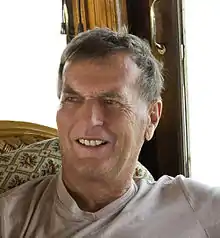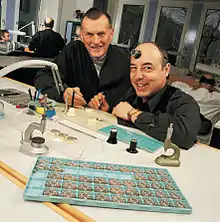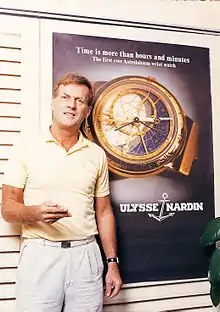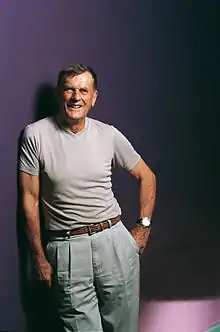Rolf W. Schnyder
Rolf W. Schnyder (1935 in Zurich – 2011 in Kuala Lumpur) was a Swiss businessman known for his role as the owner and CEO of watchmaker Ulysse Nardin.
Rolf W. Schnyder | |
|---|---|
 | |
| Born | 31 July 1935 |
| Died | 14 April 2011 (aged 75) |
| Occupation | Businessman |
| Title | Ulysse Nardin, Owner / CEO |
Biography
The journey of an adventurer
From the beginning a certain duality inhabited Rolf Schnyder's personality. On one side, his strong organizational skills and sharp analytical mind were typical of a Swiss German upbringing. However, there was also something unerringly romantic, a perpetual inquisitiveness and interest in the world beyond his immediate vicinity.
In 1956, Schnyder moved to Geneva to improve his French. Working in Jaeger-LeCoultre's advertising department on Geneva's historic Tour de L'Ile, Schnyder noticed that people in his office were easily intimidated by orders and correspondence that arrived in English. Realizing the insularity of the Swiss watch industry, Schnyder became determined to explore the world. He arranged to be posted for six months to his company's subsidiary, ‘De Travers' located on Cromwell Road in London. After this attachment he returned to Geneva, but somehow having been exposed to the sprawling universe beyond Switzerland he realized that he had to move again.
Like many young men, Schnyder was infected with wanderlust; he wanted to dive into the rich vivid colors of foreign lands, to eat things with flavors he'd never tasted and to experience new cultures with total immediacy. A newspaper clipping aroused his attention. A Swiss company named Diethelm was distributing a vast array of goods in Thailand and they were searching for a Swiss junior manager. Though only 22 years old, Schnyder instantly responded to the ad and his application was accepted. As he boarded in Genoa the “Asia”, a ship bound for South East Asia, he felt the world opening its infinite golden mysteries to him.
The stranger in strange lands
Because of his experience in the Swiss watch industry, Schnyder was immediately put in charge of Diethelm's timepiece division. Schnyder and his sales team would embark on weeklong journeys throughout Thailand trumpeting the merits of Swiss watches. Thus, while the foreign nationals gathered together to eat vague approximations of European fare in their hotels, Schnyder was at street-side restaurants learning the culture and language of his Thai friends. Schnyder's ability to remain objective and not cast a Eurocentric sense of judgment on native behavior allowed him to understand and embrace the culture of the Thai people. Lean and rangy with the rawboned good looks of an American cowboy or a professional skier, Schnyder made friends easily. He began to look forward to these sales trips, as each one offered the opportunity to learn something new about the mysterious country he now inhabited.
Schnyder also had an inborn sense of business acumen. This, combined with fine managerial skills and boundless energy, soon saw him multi-tasking. When Diethelm diversified its activities with a travel agency, Schnyder ended up running the operation. Eager to share his passion for the incredible sights of South East Asia, he initiated charter flights in a leased DC3 from Bangkok to Siem Riep where the ancient Buddhist city of Angkor Wat stood untouched by time.
In 1959 he and his friends took the historic trip down the River Kwai. They made their way through the thick forest from Kanchanaburi, a small town northwest of Bangkok, to the Burmese border. They lashed together a raft from bamboo poles with the help of a local who had plied through the forest to reclaim rails from the death railway built by Allied war prisoners during the Second World War, a task made famous by the movie, “The Bridge on the River Kwai”. From the source of the River Kwai they floated down the river on a handmade raft, capsizing at times on unexpected steep rapids. It was supposed to be a seven-day adventure trip. No one had any idea where exactly they were and how many more days were needed to get back to the office. Being late or absent was a serious offense in a tightly run Swiss office. They got finally back five days late and paid the price – a cut in holidays and bonuses. An image that Rolf Schnyder took during this adventure appeared on the cover of the Swiss magazine, Schweizer Illustrierte. An account of this trip, penned by Schnyder, could be found within its pages. It was the first of many travel reports published in Swiss and other European papers and magazines. In the next few years, Schnyder continued to explore Thailand, Laos, Bali, Cambodia and South Vietnam, where the war had just started.
He also developed a particular fondness for the white beaches around the fishing village of Pattaya which had not yet become part of the tourist track. He invested his first savings in the Nippa Lodge, Pattaya's very first hotel.
The industrious force

Advancing up the chain of command at Diethelm, Schnyder soon found himself in charge of the consumer products division. He was tasked with the distribution of basic goods from companies such as Procter and Gamble and Union Carbide. Ever the keen businessman, he soon realized that it would be more profitable to switch from imports to local manufacture under licence. This time it was his turn to share his culture — he imparted to his factory workers a Swiss sense of education, supervision and the institution of quality control. Schnyder recalls: “I was impressed with how fast the Thai people could learn new skills and how enthusiastic they were about their work. I could also see, in the way that they worked, that there was a high level of manual skill.”
Schnyder also played rugby for the Royal Bangkok Sports Club. During this period, Schnyder learned to run large-scale operations. His boundless energy and his ability to be involved in almost every aspect at the factories as well as his uncanny ability with Thai language abetted his success.
From 1966 to 1968, Schnyder switched gears. He left Thailand for a six-month voyage through the South Sea, sailing from Fiji to Samoa and around the islands of Tahiti and Bora Bora, visited South America and ended up in the head office of Philip Morris in New York where he got an assignment to develop the lucrative cigarette markets of South East Asia. Schnyder returned to Asia, basing himself in Hong Kong during the height of the Chinese Cultural Revolution. He applied for a visa to China to record with camera in hand the historical events that took place in the Empire of the Middle Kingdom. Westerners were not particularly welcome at the time. Having a neutral Swiss passport helped. Schnyder practiced reading verses of the Red Book but still got in trouble. On the last day in Guangzhou he was offered some antique gold carvings which Chinese no longer had the right to possess as they had been declared capitalist merchandise. Since no taxis were available, two hotel waiters offered their help to carry these artifacts to the railway station for the trip back to Hong Kong. On the way, the group was stopped by some Red Guards who were omnipresent in town and countryside. They objected to the fact that a Chinese carried goods for a white foreigner. The two waiters had to drop Schnyder's bags instantly and were sent home. Schnyder had to drop his travel bags as well, was taken to a building occupied by the Red Guards and made to quote verses from the Red Book backward and forward all night long. Only next morning was he released, given some tea and a bowl of rice and sent back to the street corner where the bags had been dropped by the waiters and himself the evening before. Nobody had touched them. It took Schnyder two trips on foot of 30 minutes each to get all his luggage to the railway station. He reached the Lo Wu bridge, the border between China and the then- British colony of Hong Kong, one day behind schedule. Nevertheless, Schnyder was met by a large group of journalists who were eager to buy the many photos which he had shot during the previous five days and which were later published in newspapers around the globe and in the important US magazine, “Life”.

Schnyder's job with Philip Morris took him around the world and also back to the Philip Morris European headquarters in Switzerland, where he met Charles and Marcel Stern, the cousins of Philippe Stern, president of Patek Philippe. The cousins' owned one of the best watch dial factories in Switzerland and they invited Schnyder for a guided tour.
As Schnyder watched dials materialize in the skilled hands of factory workers, a blue flash of inspiration blazed through him. He was absolutely certain that Thai workers could learn the trade of dial-making given the opportunity. The vastly lower cost of human labor in the Far East meant that Schnyder could craft watch dials of similar quality at a far lower price per unit which would permit the Swiss watch industry to stay competitive against the lower-priced products emerging from the Japan's Seiko. Charles and Marcel Stern were immediately sold on the idea, but the rigid Swiss syndicate that presided over the Swiss dial manufacturers was more difficult to convince. Finally, in 1968 Schnyder helped forge a joint partnership between Swiss and Asian investors to open the Cosmo dial and watchcase factory in Thailand. Schnyder immediately quit his job with Philip Morris and took the helm of this new enterprise.
Business boomed from the onset with Schnyder and the Cosmo team filling big orders from many Swiss watch companies like Mido, Certina, Rado, Tissot, Camy, Fortis and many others. Eventually even the iconic Swiss brand Omega was unable to disregard the tremendous savings offered. However, as business soared a fractured relationship erupted among the investors. Tiring of the politics involved, Schnyder sold his shares in Cosmo and moved to Kuala Lumpur, Malaysia in 1973.
The Precima factory, which became a key player in manufacturing watch accessories for Swiss watch companies, opened that same year. Aided by a 10- year tax-exempt grace period that allowed Schnyder to import materials tax free, business literally skyrocketed. Schnyder's trajectory of success soared. Soon he diversified to craft other micro-components, including balance springs and sapphire crystals. Business was growing at such a fast rate that Schnyder had to set up offices in Switzerland. These were located in the ASUAG building in the Seevorstadt neighborhood near Bienne. ASUAG owned several watch companies like Longines, Rado and Eterna, and key movement suppliers including ETA.
It was at this location that Schnyder met Pierre Renggli, the general manager of ASUAG, and, through him, Ernst Thomke, who headed ETA. Thomke was fascinated by the opportunities that Schnyder had created in the Far East and assisted in transferring part of the quartz module production to Precima.
Taking the path less traveled
In the winter of 1983 Schnyder found his calling, to restore one of the greatest names in high-end watchmaking to its former glory. Why buy a manufacture focused on making mechanical watches at a time when everyone told him this industry was dead? The answer to this question comes from the time Schnyder spent in Asia.
“In China and India, quartz watches were not successful,” relates Schnyder. “That is because watch repairmen would open the case backs and, for them, it was like looking into the back of a radio. In these cultures, the mechanical watch had residual value. Any competent repairman could open a watch up and service or fix it. They could see where the energy came from, they could identify with the mechanical movement. When I saw that these cultures adamantly refused at that time to embrace quartz watches, I knew that one day mechanical watches would come back.
“It is often said, but it is true, that the watch is a man's only piece of jewelry. This personal relationship becomes even stronger when the watch is mechanical. There is a beautiful symbiosis between a man and his mechanical watch. He gives the watch life by winding it and the watch unerringly serves him by providing him time. An almost fierce loyalty develops between a man and his watch.”
A new era dawns
In 1983, at 48 years of age, Schnyder returned to St. Moritz, Switzerland to ski and race his beloved skeleton bobsleds, activities that he continues to enjoy today. (He still occasionally wins a race on the Cresta Run, as he did in February 2006.)
“I was on holiday skiing when I read in the papers that Ulysse Nardin had filed for Chapter 11 (deferment of payment) to protect itself from creditors. This was during the Quartz Crisis and many famous companies in Switzerland were folding. Ulysse Nardin had many debts without any real way of paying them off,” says Schnyder. He, like many watch enthusiasts, knew Ulysse Nardin's name well. “I knew of the brand because of the many medals for accuracy and chronometric competitions that it had won. I was immediately interested in purchasing Ulysse Nardin. It was the opportunity to be involved in one of the truly great names in horology.”
However, when Schnyder visited the manufacture, he discovered nothing more than a beautiful carcass housed in the original factory building that was constructed in 1864. There was only one full-time watchmaker named Leopold Berthoud who occupied himself by creating Ulysse Nardin's marine chronometers and deck watches for collectors looking to own an anachronistic but sublimely made piece of naval history. Another person that Schnyder found at the manufacture was Jean-Jacques Haldimann. “It was essentially with these one-and-a-half employees (as Haldimann was not actually on company payroll at that time) that I started at Ulysse Nardin. I realized that if I were to undertake this resurrection, I would have to breathe life back into this carcass based on the strength of our products,” says Schnyder.
His plan for Ulysse Nardin's rebirth was to elevate it to the highest position in watchmaking. “To do this, I knew I had to make a watch that had never been made before,” he explains. Fortunately for Schnyder, the ever-helpful Haldimann was deeply embedded in the Swiss watch industry. He told Schnyder that an independent watchmaker named Jörg Spoering had created a new tourbillon. Rolf was keen to see if Spoering had other ideas for high complications. As soon as he entered Spoering's atelier in Lucerne, a bizarre clock caught his eye. Says Schnyder: “I had only a vague recollection of seeing something like it before, so I asked: ‘Is this what they call an astrolabium?' Spoering said it was and explained that the clock was made by someone named Ludwig Oechslin. He sighed and added: ‘He is supposed to be my apprentice but he is never here.'”

Three weeks later Spoering arranged for Schnyder to meet Oechslin. “I pointed to the Astrolabium clock and asked: ‘Can you make it in wristwatch size?' He puzzled for a moment and answered, genuinely confused: ‘I can, but who would want it so small.'” Rolf Schnyder smiled as he replied: “I do.”

Unveiled in 1985, the Astrolabium Galileo Galilei was a major critical and commercial success. Although the Astrolabium went down in the Guinness Book of World Records as the most complex watch made, its significance was far greater than the sum of its parts. The Astrolabium, a machine powered by human kinetic energy that told time through the ancient poetry of celestial positions, was a sign of things to come and marked “the beginning of a beautiful friendship” between the brilliant leader Schnyder and the poet-philosopher Oechslin. Together, what they would accomplish over the next two-and-a-half decades is, in a word, ‘extraordinary'.
During his years at the helm of Ulysse Nardin, Schnyder has created some of the most original and functionally innovative timepieces in horology. Rather than sticking to ‘tried-and-tested', Ulysse Nardin with the help of Ludwig Oechslin has constantly pushed the boundaries and opened up new worlds of manufacturing techniques and materials ahead of the rest of the watch industry. Ludwig's creative mind worked much faster than the small production team at the disposal of Schnyder. Schnyder followed up his awesome Astrolabium watch with the Planetarium Copernicus, a wristwatch that represents time through the shifting position of the planets in our solar system. In 1989 Ulysse Nardin, in cooperation with Christophe Claret, brought the world the first repeating wristwatch with Jaquemarts. Tiny figures carved in gold move on the dial synchronized in time to the repeater's hammer strikes.
In 1992 the manufacture completed the ‘Trilogy of Time' with the Tellurium Johannes Kepler, a watch that tells time using a stunning interpretation of our constantly rotating planet. In 1993 Schnyder unveiled the Hourstriker San Marco, the fruit of his collaboration with technical wunderkind Giulio Papi. In 1994 Ulysse Nardin shifted gears and focused on the creation of the world's most functional GMT watch. The GMT ±'s ease of use and pure simple logic has been a revelation to frequent travelers.
Then in 1996, on the 150th anniversary of his manufacture, Rolf Schnyder and Ludwig Oechslin raised the curtain on the world's most purely functional perpetual calendar. This amazing timepiece has all calendar displays synchronized and adjustable through a single crown. Because of its reliance on special epicyclical gearwheels rather than levers, this incredible watch can be quickly adjusted both forwards and backwards! In 1999 the perpetual calendar received the added GMT ± indicator. Incredibly, all calendar displays were synchronized to this local time indicator. To this day, Ulysse Nardin's perpetual calendars represent the high reference in watchmaking for this complication, a remarkable benchmark that has never been surpassed.
On the first year of the new millennium, Rolf Schnyder and Ludwig Oechslin created a wristwatch that was irrevocably to change the face of modern horology. Their audacious Freak, a 7-day carrousel tourbillon with no hands or crown, is the world's first example of horological modern art. With its purity of design involving a movement that also gives indications of time, it still stands as the most creative innovation of the 21st century watch world. The Freak single-handedly smashed every convention known to haut de gamme watchmaking and opened the floodgates of creativity. As if this isn't enough, beating within it is the Dual Direct escapement, the first successful implementation of a non-lubricated alternative to the Swiss lever escapement. The Dual Direct escapement's wheels were made in silicium, another historical first in watchmaking history.
In 2002, Schnyder launched the Genghis Khan, the world's first carillon Westminster minute repeater tourbillon with Jaquemarts. In the same year, the Freak won the Watch of the Year award. In 2003, Schnyder and Oechslin once again conspired to change the face of watchmaking with their Sonata, the world's first alarm watch that could be set 24 hours in advance and had a dual time function. Ulysse Nardin in cooperation with GFD developed the first hairspring for the balance wheel in polycrystalline diamond.
In 2005, Ulysse Nardin created an updated version of the Freak, the Freak 28'800 V/h utilizing an updated and improved version of the Dual Direct escapement called the Dual Ulysse escapement. Schnyder also introduced the word's first watch to use diamond micro-components in its escapement, the Freak Diamond Heart.
In 2006, to celebrate the 160th anniversary of the manufacture he has so assuredly led for the last 23 years, Schnyder presents the Caliber 160, Ulysse Nardin's first completely in-house designed and executed automatic caliber. This caliber features the manufacture's Dual Ulysse escapement at its heart. Innovative design allows the plate of the movement to be customized to integrate other signature complications of Ulysse Nardin, creating integrated movements rather than the modular movements that currently dominate the high watchmaking world.
When Schnyder first took the reins of Ulysse Nardin, he inherited the original, then-empty factory first built in 1864 and enlarged in 1895. Today, there are 250 inspired workers and staff at Ulysse Nardin. Moreover, each of these men and women exude a palpable sense of pride that is a singular phenomenon in Swiss watchmaking. With each success, Schnyder has focused on selfinvesting in his manufacture to create greater self-reliance and independence. The living testament to this is a huge two-storey factory plus basement located in La Chaux-de- Fonds. Opened in 2003, this factory of dreams represents the way forward and assures the enduring viable future of one of Swiss watchmaking's greatest names. This production facility, watched over by Ulysse Nardin's immensely capable technical director Pierre Gygax and chief engineer Lucas Humair, offers the manufacture great flexibility in the creation of new products. It also offers Schnyder and his team the psychological comfort of knowing that under this roof they are capable of producing almost anything necessary to the ticking entity known as the mechanical wristwatch.
With his boundless enthusiasm, clarity of vision and the conviction to constantly raise the bar in the industry, Schnyder has done what many didn't feel was possible when he first purchased Ulysse Nardin. Not only did he rescue the manufacture and return it to its former place of glory, but on the strength of his innovations he has enabled Ulysse Nardin to transcend its past and achieve an even higher place in the rarified constellation of watchmaking's legends. In his 23 years at the helm of Ulysse Nardin, Schnyder's personality and that of the manufacture have merged. They have become one. The spirit of the watchmaker Ulysse Nardin has reached out over the great ocean of time to become inextricably intertwined with Schnyder's own great warrior spirit, a spirit that can at once wholeheartedly plunge into the humor of life while taking on and out-swimming life's perilous currents. In the years he has led Ulysse Nardin, Schnyder has fulfilled his fate.

Family and personal life
Schnyder often shuttled between Switzerland and Malaysia. When he was not overseeing business in Le Locle, he was either at his home in Kuala Lumpur or visiting subsidiaries and retailers around the world. Schnyder shared a tropical home with his wife, and they are the parents of three children.
In recognition of his contributions to watchmaking, Schnyder was awarded the "Spirit of Enterprise" Gaia Award in 2003 by the Musee International d'Horlogerie for his entrepreneurial achievements and commitments. This award was followed by the bestowment of the "Lifetime Achievement Award" by the Grand Prix d'Horlogerie de Geneve: Asian Edition in Singapore for his continued contributions towards watch making technology and innovations.
When asked what he wished for when he blew out the 75 candles on his birthday cake, Schnyder commented "If I could do it all over again, I wouldn't change a thing"!
On April 14, 2011 Schnyder died at the age of 75 after a short illness. His wife attended the CHT Awards and Ball 2011 to accept the Pursuit of Excellence (Expat) Award on his behalf.
